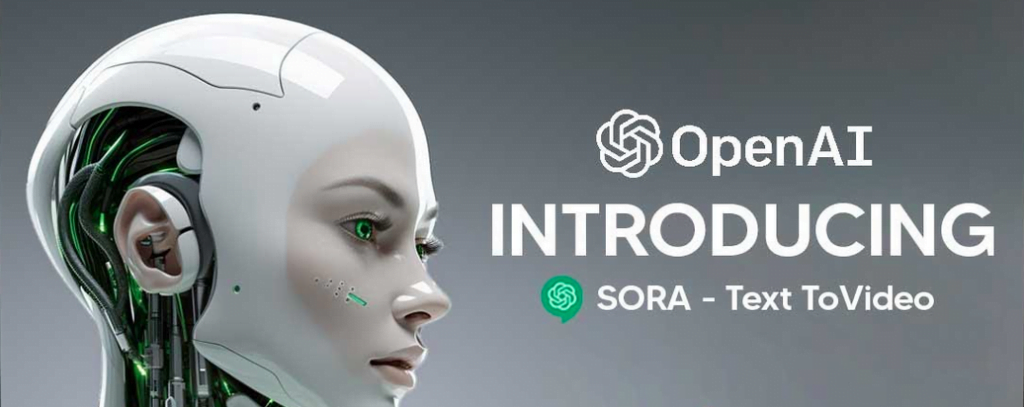Revolutionize your approach to content creation with Sora OpenAI! Are you ready to explore the cutting-edge world of video generation? In this blog post, we delve deep into the realm of Sora OpenAI, a revolutionary tool poised to transform the way we create videos. Join us as we uncover the remarkable capabilities of Sora, its inherent limitations, and the exciting potential of prompt generators to enhance its performance. Get ready to embark on a journey of discovery and innovation in the realm of visual storytelling with Sora OpenAI.

Table of Contents
Limitation 1: Sora’s Struggle with Precise Descriptions of Events Over Time
In the dynamic world of content generation, Sora OpenAI encounters challenges when tasked with providing precise descriptions of events that unfold over time. This limitation arises from the inherent complexity of simulating temporal sequences accurately. Let’s delve into this limitation and explore examples to illustrate how Sora may struggle in this aspect.
Example 1: The Rolling Ball
Imagine requesting Sora to create a video of a ball rolling down a hill. While the concept seems straightforward, accurately depicting the trajectory of the ball as it moves over time presents a significant challenge for Sora. Due to its diffusion and transformer models, Sora may face difficulties in accurately simulating the physics of the rolling ball, resulting in inconsistencies or inaccuracies in the generated video.
Example 2: Dynamic Action Sequences
In scenarios involving dynamic action sequences or complex movements, Sora’s struggle with temporal consistency becomes more apparent. For instance, generating a video of a fast-paced chase scene or a series of rapid movements may pose challenges for Sora in maintaining coherence and fluidity over time. As a result, the generated video may exhibit discrepancies or distortions in the depiction of motion, hindering its realism and believability.
Example 3: Narrative Development
Additionally, when tasked with creating videos that tell a cohesive narrative or depict sequential events, Sora’s limitations in handling temporal sequences become evident. For example, generating a video that portrays the progression of a character’s journey or the development of a storyline may prove challenging for Sora, as it struggles to maintain consistency and coherence across multiple frames and scenes.
In summary, while Sora OpenAI boasts impressive capabilities in content generation, its struggle with providing precise descriptions of events that take place over time poses a notable limitation. By understanding these challenges and exploring potential solutions, we can work towards enhancing Sora’s ability to create compelling and realistic videos with greater temporal accuracy.
Limitation 2: Physically Implausible Motion in Sora OpenAI Creations
Despite its remarkable capabilities, Sora OpenAI occasionally encounters instances where it generates visually stunning but physically implausible motion. This limitation arises from the model’s reliance on diffusion and transformer architectures, which may result in inconsistencies or inaccuracies in the depiction of motion within generated videos. Let’s explore examples to illustrate this limitation.
Example 1: Walking on Air
Imagine requesting Sora to create a video of a person walking along a city street. In some instances, Sora may produce visually captivating scenes where the person appears to walk on air, defying the laws of physics. This phenomenon occurs due to discrepancies between the model’s understanding of spatial relationships and the physical constraints of the environment, resulting in unrealistic depictions of motion.
Example 2: Floating Objects
Similarly, Sora may generate videos where objects or characters appear to float or hover unnaturally above the ground. This anomaly occurs when the model fails to accurately simulate gravitational forces or interactions between objects, leading to visually jarring scenes that detract from the overall realism of the video.
Example 3: Unnatural Movements
Additionally, Sora’s creations may exhibit instances of unnatural or jerky movements, particularly in scenes involving complex actions or interactions. For example, a video depicting a character performing acrobatic maneuvers may suffer from inconsistencies in motion, resulting in disjointed or disjointed sequences that detract from the viewer’s immersion.
In summary, while Sora OpenAI excels in generating visually captivating content, its tendency to produce physically implausible motion represents a notable limitation. By acknowledging these challenges and exploring strategies to address them, we can work towards enhancing Sora’s ability to create videos with greater realism and coherence.
Limitation 3: Spontaneous Appearance of Entities in Sora-Generated Videos
One of the intriguing yet occasionally problematic aspects of Sora OpenAI is its propensity for entities, such as animals or people, to spontaneously appear within generated videos, particularly in scenes containing numerous elements. While Sora generally excels in creating visually appealing content, this phenomenon can sometimes result in unexpected and unrealistic scenarios. Let’s delve into some examples to illustrate this limitation.
Example 1: Sudden Appearance of Characters
Consider requesting Sora to generate a video featuring a bustling city street filled with pedestrians. In some instances, Sora may introduce additional characters into the scene abruptly, without any prior indication or logical progression. This spontaneous appearance of characters can disrupt the flow of the video and create inconsistencies in the narrative, detracting from the overall realism of the scene.
Example 2: Unexpected Animal Presence
Similarly, when generating videos depicting natural landscapes or wildlife, Sora may introduce animals into the scene unexpectedly. For instance, a video showcasing a serene forest setting may suddenly feature a deer or bird that was not previously present in the environment. While these additions may enhance the visual appeal of the video, they can also lead to incongruities and inconsistencies in the depicted environment.
Example 3: Overcrowded Scenes
In scenes with many entities, such as crowded city squares or bustling marketplaces, Sora may struggle to maintain coherence and spatial consistency. As a result, additional entities may appear spontaneously to fill perceived gaps in the scene, leading to overcrowded and chaotic compositions that deviate from the intended aesthetic or narrative.
In summary, while Sora OpenAI demonstrates impressive capabilities in generating diverse and visually engaging content, its tendency for entities to spontaneously appear in videos represents a notable limitation. By addressing these challenges and refining the model’s understanding of spatial relationships and scene composition, we can work towards enhancing Sora’s ability to produce videos with greater coherence and realism.
Limitation 4: Constraints in Complexity, Style Variety, and Nuance
Despite its remarkable capabilities, Sora OpenAI exhibits certain limitations when it comes to complexity, style variety, and the nuanced elements present in human-generated videos. While the model excels in many scenarios, it may struggle to replicate the intricacies and subtleties inherent in human creativity and expression. Let’s explore these constraints in more detail.
Limited Complexity:
Sora’s ability to handle complex scenes and narratives is somewhat restricted compared to human-generated content. While it can generate visually appealing videos across a range of scenarios, the model may encounter challenges when tasked with highly intricate or multifaceted concepts. Complex narratives with multiple plotlines or intricate visual compositions may not be faithfully reproduced by Sora, leading to simplified or overly streamlined representations.
Style Variability:
Another limitation of Sora OpenAI is its relatively limited range of artistic styles and visual aesthetics. While the model can produce videos in various styles, its repertoire may not be as diverse or extensive as that of human creators. This can result in a lack of stylistic variety in generated content, with videos often exhibiting similarities in composition, color palette, and overall aesthetic.
Inability to Capture Subtle Nuances:
Human-generated videos often contain subtle nuances, emotions, and cultural references that contribute to their richness and depth. However, Sora may struggle to replicate these nuanced elements accurately. Emotional subtleties, cultural references, and nuanced expressions may be overlooked or simplified in Sora-generated videos, leading to a loss of depth and authenticity in the final output.
Challenges in Creative Expression:
Additionally, Sora’s ability to express creativity and originality may be limited compared to human creators. While the model can generate impressive visual content based on input prompts, its capacity for genuine creative expression and innovation may be constrained. This can result in videos that, while visually appealing, lack the ingenuity and unique perspective often found in human-generated content.
In summary, while Sora OpenAI demonstrates remarkable capabilities in content generation, it is not without its limitations. Constraints in complexity, style variability, and the ability to capture subtle nuances pose challenges to the model’s ability to replicate the richness and depth of human-generated videos. By acknowledging these limitations and exploring avenues for improvement, we can work towards enhancing Sora’s capacity to produce more diverse, nuanced, and expressive content.
Ethical Considerations: Addressing Sora OpenAI’s Impact
As with any advanced technology, Sora OpenAI’s capabilities raise significant ethical considerations, particularly concerning its potential to exacerbate existing inequalities if not distributed equitably. Let’s delve into the ethical implications of Sora’s capabilities and explore ways to mitigate these concerns.
Potential for Inequitable Distribution:
One of the primary ethical concerns surrounding Sora OpenAI is its potential to widen existing inequalities if access to and training in using the technology are not distributed equitably. As a powerful tool for content creation, Sora has the capacity to democratize video production and unlock new creative possibilities. However, without equitable access and training opportunities, certain individuals or groups may be marginalized or excluded from benefiting fully from the technology.
Amplifying Bias and Discrimination:
Another ethical consideration is the risk of Sora perpetuating or amplifying bias and discrimination present in the training data. Like other AI models, Sora learns from datasets that may contain implicit biases or stereotypes, which can manifest in the generated content. Without careful oversight and mitigation strategies, Sora-generated videos could inadvertently reinforce harmful stereotypes, perpetuate discriminatory narratives, or marginalize certain groups.
Impact on Creative Industries:
Sora’s capabilities also have implications for the creative industries, including concerns about job displacement and the devaluation of human creativity. While Sora has the potential to streamline video production processes and empower creators with new tools and techniques, there is a risk that widespread adoption of the technology could lead to job loss or diminished opportunities for human creators. Additionally, the widespread availability of AI-generated content may contribute to the commodification of creativity and the devaluation of original artistic work.
Mitigating Ethical Concerns:
To address these ethical concerns, it is essential to implement robust governance frameworks, ethical guidelines, and accountability mechanisms for the responsible development and deployment of Sora OpenAI. This includes promoting transparency and accountability in the use of AI technologies, ensuring equitable access to training and educational resources, and actively addressing biases and discrimination in training data and algorithms. Additionally, fostering collaboration between technologists, policymakers, ethicists, and stakeholders can help identify and address ethical challenges proactively.
In summary, while Sora OpenAI holds immense potential for innovation and creativity, it is crucial to approach its development and deployment with careful consideration of the ethical implications. By prioritizing equity, transparency, and responsible governance, we can harness the transformative power of Sora while mitigating potential risks and ensuring that the technology benefits society as a whole.
Impact on Content Creation: Analyze how the limitations of Sora affect content creation processes and the quality of generated videos
The limitations of Sora OpenAI significantly influence content creation processes and the quality of generated videos. While Sora OpenAI offers a groundbreaking approach to video generation, its shortcomings can pose challenges for content creators seeking high-quality and realistic results.
One notable impact is the potential for increased production time and effort. When Sora OpenAI struggles with precise descriptions of events over time or creates physically implausible motion, creators may need to spend additional time refining and editing generated videos to achieve the desired outcome. This can lead to delays in content delivery and increased production costs.
Moreover, the limitations of Sora OpenAI can affect the overall quality and realism of generated videos. Instances where animals or people spontaneously appear, or when scenes lack complexity and style variety, can result in videos that feel disjointed or unrealistic. This can diminish the viewer’s experience and affect the credibility of the content.
Additionally, content creators may face challenges in maintaining consistency and coherence across generated videos. Sora OpenAI’s limited ability to capture subtle nuances compared to human-generated videos can result in inconsistencies in tone, style, or visual elements throughout a video sequence. This can detract from the overall cohesion and impact of the content.
Overall, the limitations of Sora OpenAI underscore the importance of understanding its capabilities and constraints when leveraging it for content creation. While Sora OpenAI presents exciting opportunities for innovative video production, addressing its limitations is essential for achieving optimal results and delivering engaging and compelling content to audiences.
Potential Solutions: Leveraging Sora Prompt Generators
While Sora OpenAI offers groundbreaking capabilities for content generation, it’s not without its limitations. However, there’s hope on the horizon in the form of Sora prompt generators. These tools aim to address the challenges posed by Sora’s limitations by providing more precise prompts and guiding the video generation process. Let’s explore how Sora prompt generators can enhance the effectiveness and efficiency of content creation.
Precision in Prompting:
One of the primary benefits of using a Sora prompt generator is the ability to provide more detailed and precise instructions to the Sora model. By leveraging structured prompts, users can communicate their vision more clearly, reducing ambiguity and potential misinterpretations. This precision in prompting enables Sora to generate videos that align more closely with the user’s intentions, resulting in higher-quality output.
Guidance in Video Generation:
Sora prompt generators also serve as invaluable tools for guiding the video generation process. By breaking down the scene into specific elements such as setting, characters, actions, and emotions, prompt generators help users articulate their vision comprehensively. This structured approach not only streamlines the video creation process but also ensures that important details are not overlooked, leading to more coherent and engaging videos.
Enhanced Realism and Creativity:
Another advantage of using a Sora prompt generator is its potential to enhance the realism and creativity of Sora-generated videos. By incorporating realistic details, nuanced character behaviors, and creative concepts into the prompts, users can inspire Sora to produce more lifelike and imaginative content. Whether it’s simulating complex interactions or exploring innovative visual styles, prompt generators empower users to push the boundaries of what’s possible with Sora.
Iterative Improvement:
Furthermore, Sora prompt generators facilitate an iterative approach to content creation, allowing users to refine and iterate on their prompts based on feedback and experimentation. This iterative process enables users to fine-tune their vision, address any shortcomings or inconsistencies in the generated videos, and ultimately achieve their desired results. By continuously refining their prompts, users can maximize the potential of Sora and unlock new creative possibilities.
Collaborative Collaboration:
Finally, Sora prompt generators foster collaboration and knowledge sharing among users, enabling them to exchange ideas, share best practices, and learn from each other’s experiences. By building a community around Sora prompt generation, users can collectively explore the capabilities of Sora, discover innovative techniques, and contribute to the ongoing development of the technology. This collaborative approach not only enriches the user experience but also accelerates the evolution of Sora as a tool for content creation.
Sora prompt generators offer a promising solution to address the limitations of Sora OpenAI by providing more precise prompts and guiding the video generation process. By leveraging these tools, users can enhance the effectiveness, efficiency, and creativity of their content creation endeavors, paving the way for a new era of digital storytelling and visual expression.
Use Cases: Harnessing the Power of Sora Prompt Generators Across Industries
Sora OpenAI prompt generators hold immense potential to revolutionize content creation across a wide range of industries. Let’s explore some compelling examples of how these tools can be leveraged to overcome Sora’s limitations and enhance content creation in various sectors:
1. Entertainment and Media:
In the entertainment industry, Sora prompt generators can be used to streamline the production of visual effects, animated sequences, and virtual environments for films, TV shows, and video games. By providing detailed prompts for specific scenes, filmmakers and game developers can ensure that Sora generates visuals that seamlessly integrate with live-action footage or game environments, enhancing the overall cinematic experience.
2. Advertising and Marketing:
Sora prompt generators offer marketers and advertisers a powerful tool for creating engaging and impactful promotional content. Whether it’s crafting eye-catching animations, dynamic product demonstrations, or immersive brand experiences, prompt generators enable marketers to communicate their message effectively and capture the attention of their target audience. By tailoring prompts to align with their brand identity and marketing objectives, businesses can leverage Sora to produce compelling visual content that drives engagement and conversion.
3. Education and Training:
In the field of education and training, Sora prompt generators can facilitate the development of interactive learning materials, virtual simulations, and instructional videos. Educators and trainers can use these tools to design engaging and immersive educational experiences that cater to diverse learning styles and preferences. By incorporating interactive elements, realistic scenarios, and dynamic visualizations into their prompts, educators can enhance student engagement, retention, and comprehension, making learning more effective and enjoyable.
4. Architecture and Design:
For architects, designers, and urban planners, Sora prompt generators offer a valuable tool for visualizing architectural concepts, interior designs, and urban landscapes. By providing detailed prompts for building layouts, spatial configurations, and environmental contexts, designers can explore different design iterations, evaluate spatial relationships, and communicate their ideas effectively to clients and stakeholders. Prompt generators enable architects and designers to create realistic and immersive visualizations that bring their projects to life and facilitate informed decision-making throughout the design process.
5. Healthcare and Medicine:
In the healthcare sector, Sora prompt generators can support medical education, patient communication, and clinical decision-making. Healthcare professionals can use these tools to create interactive anatomical models, procedural simulations, and patient education materials. By providing detailed prompts for medical scenarios, clinicians can simulate realistic patient encounters, practice diagnostic skills, and explore treatment options in a safe and controlled environment. Prompt generators empower healthcare professionals to enhance their clinical skills, improve patient outcomes, and deliver high-quality care.
6. Gaming and Virtual Reality:
In the gaming and virtual reality industries, Sora prompt generators offer game developers and VR content creators a versatile tool for generating immersive environments, character animations, and interactive experiences. By providing detailed prompts for game levels, character interactions, and gameplay mechanics, developers can design compelling gaming experiences that captivate players and immerse them in virtual worlds. Prompt generators enable game developers to explore creative concepts, iterate on game designs, and deliver memorable gaming experiences that push the boundaries of storytelling and interactivity.
In summary, Sora prompt generators have the potential to revolutionize content creation across a diverse range of industries, from entertainment and advertising to education and healthcare. By harnessing the power of these tools, businesses and professionals can overcome the limitations of Sora OpenAI and unlock new opportunities for innovation, creativity, and engagement in their respective fields.
Advancing Sora OpenAI for the Future
In this comprehensive exploration of Sora OpenAI and its potential impact on content generation, we’ve uncovered both its remarkable capabilities and its inherent limitations. From struggling with precise descriptions of events to creating physically implausible motion, Sora faces challenges that hinder its ability to generate high-quality videos consistently. However, with these limitations come opportunities for innovation and improvement.
Through the discussion of Sora prompt generators, we’ve highlighted a promising avenue for addressing these limitations. By providing more precise prompts and guiding the video generation process, prompt generators offer a viable solution for enhancing the quality and realism of Sora-generated content across various industries. From entertainment and marketing to education and healthcare, prompt generators hold the key to unlocking Sora’s full potential and enabling its seamless integration into diverse workflows and applications.
Looking ahead, future advancements in machine learning, natural language processing, and computer vision hold the promise of further enhancing Sora’s capabilities and expanding its utility. By leveraging cutting-edge technologies and methodologies, researchers and developers can continue to push the boundaries of what’s possible with Sora, enabling it to generate increasingly realistic, dynamic, and engaging videos that rival those created by human professionals.
Moreover, as we navigate the ethical considerations surrounding Sora’s capabilities, it’s essential to prioritize transparency, accountability, and responsible use. By implementing robust safeguards, guidelines, and governance mechanisms, we can mitigate the risks associated with Sora-generated content and ensure that it is used ethically and responsibly across different contexts and applications.
In conclusion, while Sora OpenAI may currently have its limitations, it also holds immense promise for revolutionizing content creation and shaping the future of visual storytelling. By embracing innovation, collaboration, and continuous improvement, we can harness the full potential of Sora and usher in a new era of creativity, efficiency, and impact in the world of content generation.





